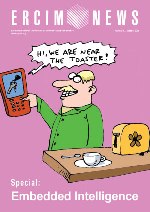by Ben Schouten and Onkar Ambekar
Embedded systems and ambient technology enable users to interact at any time and anywhere. In the BASIS project for identity management, CWI investigates transparent biometrics in home environments. Possible application areas are user profiling for shopping , listening to ones favourite music and operating gadgets and appliances in the home.
Historically, personal relationships, face-to-face encounters, notaries, and third party counsel verified our identity. Nowadays, reliance on paper has shifted to electronic documents and in the same way, reliance on traditional trust factors has had to shift to electronic authentication for exchanging information, goods, and services. As territories and communities are newly defined in the digital age, there is a need for a new definition of digital identity. The question is: Do we possess only one "federal identity" as in our passport, or do we allow the use of partial identities, depending on the application we are using or on the relationship or community of which we are a part? (See Figure 1.)
The research project Biometric Authentication Supporting Invisible Security (BASIS) tries to answer these questions. It aims to develop authentication protocols in networked and distributed systems and, in particular, studies robust face recognition in images from multiple cameras. Users will have an aware, adaptive and responsive personal space, in the home environment. The aim is to investigate the possibilities of biometric authentication for securing access to information and services in this personal environment, with a focus on user convenience and privacy protection.
The research project addresses three topics in the following work packages (WPs). The WP Transparent Biometrics is about transparent biometric authentication (read without taking any specific action) as a means to enhance user convenience - for instance, to automatically hear your favourite music. The WP Template Protection is about anonymous biometric authentication as a means of protecting the user's privacy and the WP Home Biometrics is about the specific problems of biometric authentication in the home environment. Research at CWI, WP leader for Home Biometrics, started in January 2006.
In the home environment, it is unlikely that biometrics based on the recognition of one modality - such as speech or vision - will suffice. If we want to provide the user with easy and transparent use we should be able to identify subjects in changing and uncontrolled conditions. In the project, identity is not defined as a unique set of personal data, like name or age, but more generally. Height, weight, or anything that can be used to classify user profiles is used. For example, we are not interested in the name of the toddler who is approaching a dangerous stairway in order to automatically close the stair gate.
With BASIS, information from different sensors (speech, video etc) will be fused and analysed to produce a coherent interpretation. The main complexity here stems from the heterogeneity of the data sources. As a consequence of small user groups in the home environment it makes sense to include so-called lightweight or "soft" biometrics like weight, height or the location of a subject to improve reliability.
Up to now, many ways of fusing data have been investigated. In the case of a recognition system, they can roughly be divided into four groups according to the level on which fusion takes place: pre-processing level, feature level, likelihood score level and decision level. As we will cope with uncertain inputs and changing modularity, the best candidate is the likelihood score level. A very promising candidate for solving the fusion task is to use a Bayesian network (BN) or an extension. Using BN, one can cope with uncertain inputs and prior knowledge (in the form of beliefs and statistics), which could be incorporated in a BN. Also Kalman-filters and HMM approaches, used widely and successfully for coping with noisy inputs and tracking, could be expressed in terms of Bayesian networks.
The project outcomes can support future applications in smart environments, adaptive physical environments, profiling applications, and parental restrictions (see Figure 2). In the future we foresee people carrying wireless identity tokens, for example in a handheld phone, RFID or implanted chip, constituting partial identities by which people present themselves, enabling them to authenticate transparently by using different applications. To avoid privacy constraints and repudiation, leaving control in the hand of the user, negotiation and interaction in the authentication process, are essential. Just as in the "old days" when police would take down your name and address as a consequence of jumping a traffic light.
The research consortium consists of University of Twente, University of Eindhoven, CWI and Philips HomeLab and is co-financed by IOP GenCom of the Dutch Ministery of Economic Affairs. In the course of the four-year project the results will be demonstrated in the Philips Homelab. In the short time the project has been in existence, results have already led to a patent application.
Link:
http://www.cwi.nl/pna4
Please contact:
Ben Schouten
CWI and FONTYS, The Netherlands
Tel: +3120 5924050
E-mail: B.A.M.Schouten![]() cwi.nl
cwi.nl










